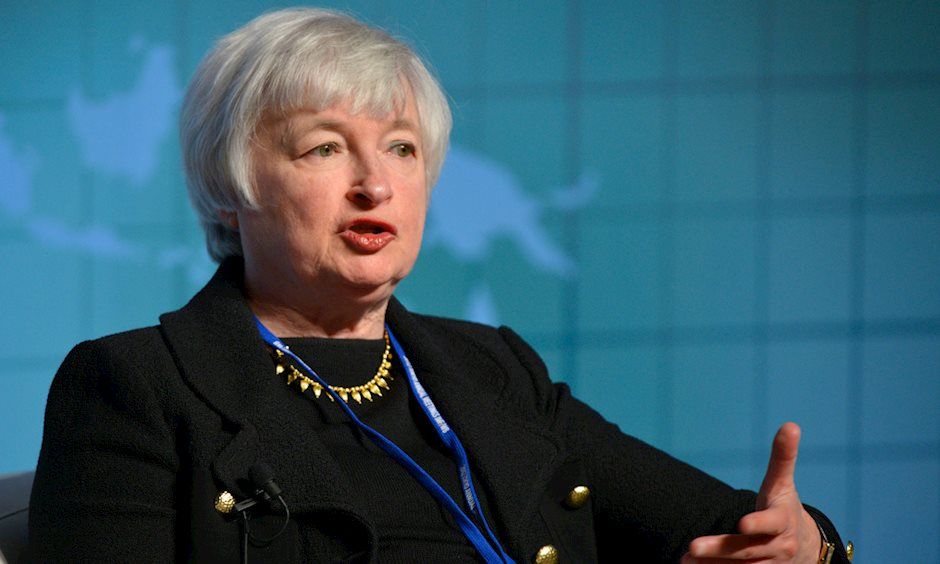Where now for Federal Reserve policy? - ING

Analysts at ING noted that Chair Yellen has re-affirmed the Fed's position, we should be braced for higher US rates. But the market still remains sceptical.
Key Quotes:
"Where do the risks lie?
Four versus one
Ahead of last week’s FOMC meeting, the market was sensing low inflation readings would lead the Federal Reserve to adopt a more cautious view on the likely path for monetary policy. Instead, we got a statement suggesting while the Committee is “monitoring inflation developments closely” they continue to believe low inflation readings are transitory and they will “stabilise around the Committee’s 2% objective over the medium term”.
In the Fed’s view the monetary policy stance remains “accommodative” and “gradual increases” in the Fed funds rate are warranted. Moreover, the updated forecasts showed individual members sticking to their guns in predicting rates will be raised again before the end of the year and that we should be prepared for three more rate rises next year.
This view was supported by Fed Chair Janet Yellen in her speech today where (she arguably goes further) and states officials should be "wary of moving too gradually" and that it is "imprudent" to wait until inflation is above 2% before raising interest rates.
Nonetheless, markets remain sceptical, fully pricing in just one rate rise before the end of 2018. This is a huge difference from the four hikes the Fed are indicating, but in fairness, some factors justify caution.
Firstly, the Fed has overpredicted the path of the policy rate on several occasions, and in an environment, with low inflation and subdued wage growth there is little to suggest the need for major policy tightening
Then there is the fact that the FOMC is changing. Vice Chair Stanley Fischer has resigned, effective 13 October and Yellen’s term as Governor ends in February 2018 and we are yet to know if she will be re-appointed. There are already three vacancies on the Fed Board so President Trump has the option of radically changing the makeup of the FOMC which could significantly change the prospects for rate hikes.
Government shutdown risks
Another factor that makes the market doubt the Fed's predictions is the proximity of the next FOMC meeting in December to the debt ceiling extension date. The two differ by two days and if there is no agreement to raise the debt limit, the US government will be unable to borrow money and will instead have to default (given tax revenues aren’t enough to cover expenditure), either to workers or supplies or on its debt payments.
In the past, we have seen hundreds of thousands of workers furloughed because of this and during the 2013 crisis the US lost its AAA rating with S&P and the Dow Jones equity index fell 17%. Given politics is so divisive in Washington right now, the possibility of another shutdown can't be ruled out. This may prompt the Fed to tread cautiously, not wanting to add potential financial market strains by tightening monetary policy.
In defense of the Fed
The Fed’s forecast for the path of policy may look aggressive to some, but the underlying health of the US economy justifies this.
Unemployment is at a 16 year low, confidence is at healthy levels, the economy expanded at a 3% annualised rate in 2Q17, and it may do the same in 3Q17. If Donald Trump can deliver on tax reform that can improve the prospects for consumer and business spending, this will add to the upside for growth.
Then there is inflation. It's likely to rise and push above the 2% target. Refinery outages because of Hurricane Harvey have pushed up gasoline prices, and oil prices are now hitting new highs, suggesting the energy component will support overall inflation. The dollar’s 10% depreciation on a trade-weighted basis is contributing to higher import prices with both headline and core (ex-food & energy) producer price inflation accelerating sharply. We are also seeing some signs that wages may tentatively be responding to the tightness in the labour market, which will push up service sector inflation in particular.
In this regard, Yellen warned that "without further modest increases in the federal funds rate over time, there is a risk that the labour market could eventually become overheated, potentially creating an inflationary problem down the road that might be difficult to overcome without triggering a recession."
At the same time, the Fed has cited other factors that justify the tighter policy. These include relatively loose financial conditions for which we can point to dollar weakness and the relatively flat yield curve. Some Fed officials have suggested that this gives them greater scope to tighten monetary policy through a higher Fed funds rate.
Then there is the issue of asset valuations. In June, Yellen suggested that asset prices on some valuation metrics were “somewhat rich”, but her warnings appear to have fallen on deaf ears with equity prices continuing to grind higher. The Fed has little ammunition to deal with the fallout from any sharp correction so early action to try and prevent bubbles forming seems to be on their agenda.
In this regard, Janet Yellen added today that "persistently easy monetary policy might also eventually lead to increased leverage and other developments, with adverse implications for financial stability. For these reasons, and given that monetary policy affects economic activity and inflation with a substantial lag, it would be imprudent to keep monetary policy on hold until inflation is back to two percent."
Author

Ross J Burland
FXStreet
Ross J Burland, born in England, UK, is a sportsman at heart. He played Rugby and Judo for his county, Kent and the South East of England Rugby team.

















